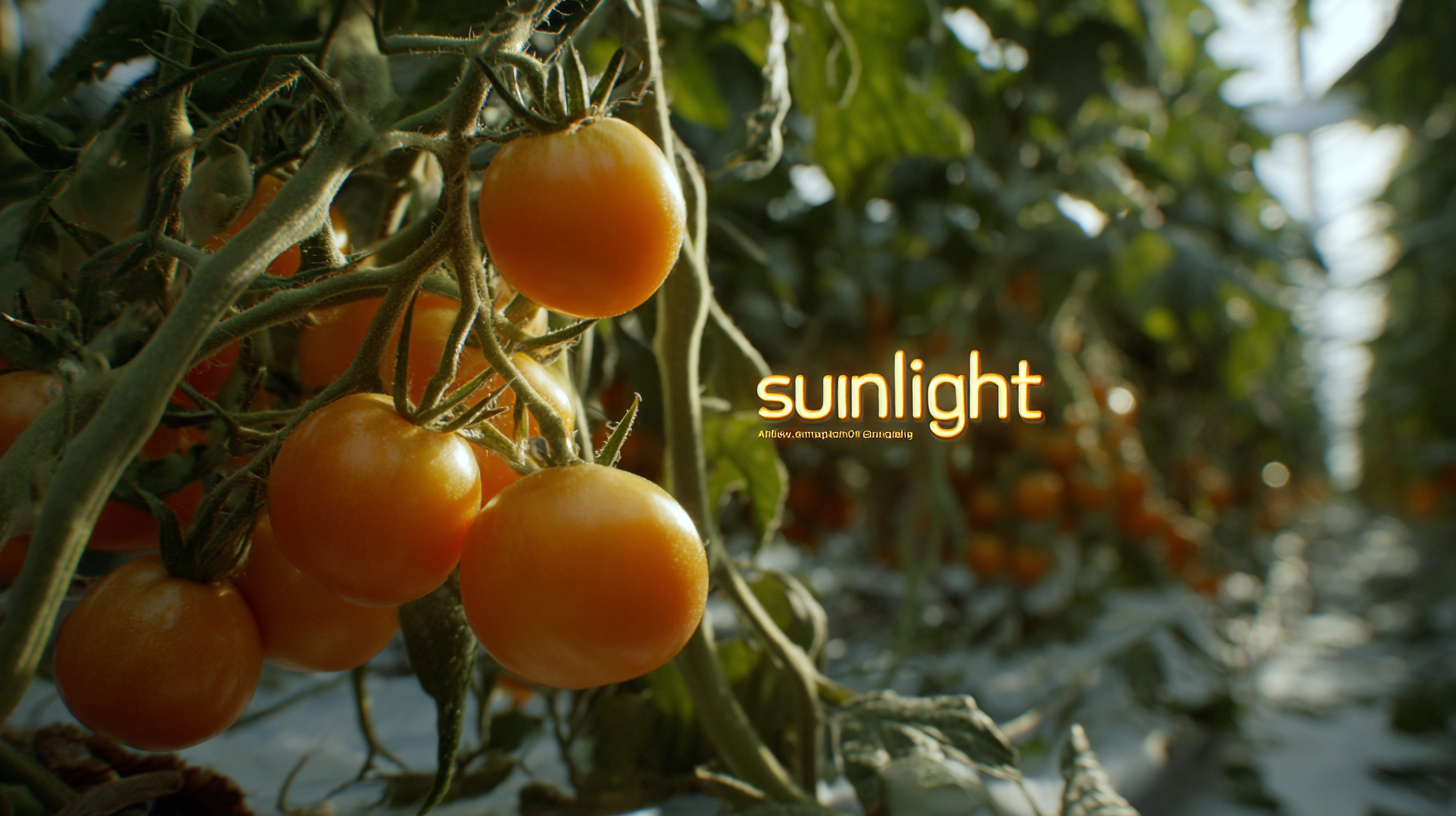Innovative Applications of the Best Sunlight Lamp in Agriculture Boosting Crop Yield and Sustainability
In recent years, the agriculture industry has witnessed a remarkable transformation driven by innovative technologies aimed at enhancing crop yield and promoting sustainability. One such breakthrough is the application of the sunlight lamp, which mimics natural sunlight to create optimal growing conditions for various crops.
 As farmers seek solutions to counter climate challenges and resource limitations, sunlight lamps have emerged as a vital tool that leverages artificial lighting to extend growing seasons and improve plant health. This ultimate guide delves into the innovative applications of sunlight lamps in agriculture, exploring how these advanced lighting systems not only boost productivity but also contribute to sustainable farming practices.
By harnessing the power of artificial sunlight, farmers can cultivate crops more efficiently, reduce their carbon footprint, and meet the increasing global food demand, making sunlight lamps a game-changer in the agricultural landscape.
As farmers seek solutions to counter climate challenges and resource limitations, sunlight lamps have emerged as a vital tool that leverages artificial lighting to extend growing seasons and improve plant health. This ultimate guide delves into the innovative applications of sunlight lamps in agriculture, exploring how these advanced lighting systems not only boost productivity but also contribute to sustainable farming practices.
By harnessing the power of artificial sunlight, farmers can cultivate crops more efficiently, reduce their carbon footprint, and meet the increasing global food demand, making sunlight lamps a game-changer in the agricultural landscape.
Exploring the Role of Sunlight Lamps in Modern Agriculture Practices
 The integration of sunlight lamps in modern agricultural practices has transformed the way farmers approach crop cultivation. These innovative lamps mimic the natural spectrum of sunlight, providing an ideal environment for plant growth, particularly in regions where sunlight is limited or inconsistent. By harnessing the benefits of sunlight lamps, farmers can optimize photosynthesis, leading to healthier plants and increased yields. This technology not only supports vegetable and fruit growers but also enhances the growth of ornamental plants, expanding the market and improving profitability.
The integration of sunlight lamps in modern agricultural practices has transformed the way farmers approach crop cultivation. These innovative lamps mimic the natural spectrum of sunlight, providing an ideal environment for plant growth, particularly in regions where sunlight is limited or inconsistent. By harnessing the benefits of sunlight lamps, farmers can optimize photosynthesis, leading to healthier plants and increased yields. This technology not only supports vegetable and fruit growers but also enhances the growth of ornamental plants, expanding the market and improving profitability.
In addition to boosting crop yields, sunlight lamps play a crucial role in promoting sustainability in agriculture. They reduce dependency on chemical fertilizers and pesticides, as plants grown under constant, controlled light conditions are often more resilient and can better fend off pests and diseases. Furthermore, these lamps can be strategically used in hydroponic and vertical farming systems, which require less land and water than traditional farming methods. As a result, integrating sunlight lamps into agricultural practices not only drives productivity but also contributes to a more sustainable and environmentally friendly food system.
Enhancing Crop Growth: The Science Behind Artificial Sunlight Technology
Artificial sunlight technology has transformed modern agriculture, providing significant advantages in enhancing crop growth. Recent studies indicate that indoor farming operations utilizing full-spectrum sunlight lamps can increase crop yields by up to 30% compared to traditional methods that rely exclusively on natural light. This is particularly beneficial in regions where seasonal changes limit effective crop production. The use of artificial light not only extends the growing season but also allows for year-round cultivation, enhancing food security.
The science behind artificial sunlight technology hinges on its ability to mimic the natural light spectrum, crucial for photosynthesis. According to the USDA’s Agricultural Research Service, light wavelengths between 400 to 700 nanometers are essential for plant growth, facilitating key processes such as seed germination and flowering. Moreover, innovative systems utilizing LED sunlight lamps have been shown to consume up to 70% less energy than conventional lighting technologies, thereby promoting sustainability in farming practices. As the industry shifts towards environmentally friendly methods, adopting these technologies represents a step forward in achieving efficient and sustainable agricultural practices.
Sustainable Farming: How Sunlight Lamps Contribute to Eco-Friendly Agriculture
In the pursuit of sustainable farming practices, sunlight lamps have emerged as a key technological advancement, playing a vital role in enhancing crop yield and maintaining ecological balance. These innovative lighting solutions simulate natural sunlight, offering a controlled environment for plants to thrive. By harnessing the power of advanced LED technology, farmers are now able to achieve optimal lighting conditions tailored to the specific needs of their crops, regardless of external weather conditions. This ability not only boosts productivity but also significantly reduces the reliance on conventional farming methods that can deplete natural resources.
The integration of sunlight lamps in vertical farming systems exemplifies a forward-thinking approach to agriculture. In these settings, controlled environment agriculture utilizes artificial light sources to promote healthy plant growth. As Professor Changhoo Chun highlights, the application of strategic lighting conditions is crucial in maximizing photosynthesis and other growth processes. This intelligent use of light not only fosters higher yields but also supports sustainable practices that can help mitigate the effects of climate change, such as reduced water usage and energy efficiency. By investing in these technologies, the agricultural sector can contribute to a more resilient and eco-friendly food production system.
Case Studies: Successful Implementation of Sunlight Lamps in Crop Production
In recent years, the integration of sunlight lamps into agriculture has emerged as a transformative approach to enhance crop yield and sustainability. A key focus of this innovation is the specialized use of broad-spectrum lighting, which has been shown to significantly improve growth parameters in various crops. For instance, research indicates that adjusting the timing and duration of supplemental light can lead to a 20-30% increase in yield for greenhouse crops like basil, while optimizing nutrient bioaccumulation and light use efficiency. This customization of light exposure allows growers to tailor their production methods according to seasonal changes, thus maximizing profitability and resource utilization.

Case studies from various sectors highlight the successful implementation of sunlight lamps in crop production. One notable example involves cannabis growers exploring intercanopy lighting techniques. These growers formed research groups to investigate lighting applications that target flowers directly, leading to improved photon conversion efficiency and a marked increase in both yield and flower quality. Additionally, the ongoing exploration of controlled environment agriculture (CEA) reveals a strong trend towards leveraging advanced lighting systems to enhance plant-light interactions, demonstrating significant advancements in agricultural techniques aimed at achieving higher output in limited spaces. As technologies continue to evolve, the agricultural community is poised to embrace these innovative lighting solutions, making strides toward greater sustainability and productivity.
The Future of Agriculture: Innovations in Sunlight Lamp Technology to Boost Yields
The future of agriculture is increasingly intertwined with technological advancements, and sunlight lamp technology is at the forefront of this transformation. These innovative lamps are designed to mimic natural sunlight, providing essential wavelengths that promote photosynthesis in crops. By utilizing such technology, farmers can enhance crop growth even in less-than-ideal conditions, ensuring high yields and resilience against climate variations.
Moreover, integrating sunlight lamps into farming practices contributes to sustainability. With the ability to control light exposure and intensity, farmers can optimize energy consumption and reduce reliance on traditional fossil fuel-based methods. This not only leads to lower operational costs but also aligns with global efforts to promote environmentally friendly agriculture. As we look ahead, the integration of advanced sunlight lamp systems promises a revolutionary shift, paving the way for a more sustainable and productive agricultural landscape.
